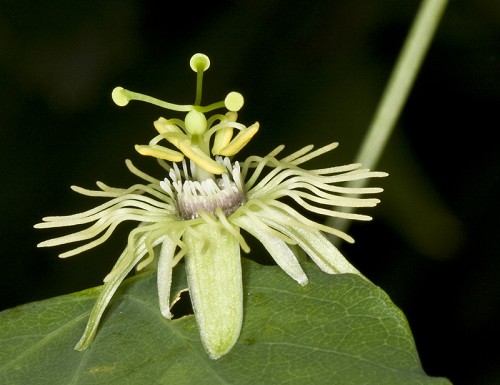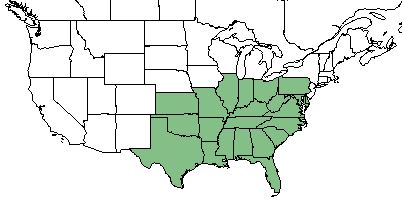Passiflora lutea
Common names: yellow passionflower[1], little passionflower[2]
| Passiflora lutea | |
|---|---|

| |
| Photo by John Gwaltney hosted at Southeastern Flora.com | |
| Scientific classification | |
| Kingdom: | Plantae |
| Division: | Magnoliophyta - Flowering plants |
| Class: | Magnoliopsida - Dicots |
| Order: | Violales |
| Family: | Passifloraceae |
| Genus: | Passiflora |
| Species: | P. lutea |
| Binomial name | |
| Passiflora lutea L. | |

| |
| Natural range of Passiflora lutea from USDA NRCS Plants Database. | |
Contents
Taxonomic Notes
Synonyms: none[2]
Varieties: Passiflora lutea var. glabriflora Fernald; P. lutea var. lutea[2]
Description
P. lutea is a perennial forb/herb/vine of the Passifloraceae family that is native to North America.[1]It climbs with axillary, simple tendrils. Its leaves are alternate, simple, and stipulate. The flowers are actinomorphic, solitary, ar fascicled in the leaf axils. There are five sepals, five petals, and a conspicuous corona. There are 5 stamens, 3 styles, capitate stigmas, and a 3-locular ovary. The sepals are 5-20 mm long, green, pale yellow, or white. The petals are 5-11 mm long, greenish-yellow to white, and the berry is 7-12 mm long. The petiole lacks paired glands, while the leaf blade lacks laminar glands.[2]
Distribution
P. lutea is found throughout the southeastern United States; from Florida north to Pennsylvania, and west to Texas and Kansas.[1]
Ecology
Habitat
P. lutea has little tolerance for drought conditions and a low tolerance for fire. It is extremely tolerant of shade.[1] Common environments for P. lutea include woodlands, forests, thickets, and maritime forests.[3]
Specimens have been recovered from edges of maritime hammocks, disturbed roadsides near woodlands, on bases of slopes, and pine-oak woodlands.[4]
P. lutea has shown resistance to regrowth in response to agricultural-based soil disturbance in South Carolina coastal plain communities, making it an indicator species for remnant woodlands.[5]
Phenology
P. lutea flowers from May through September and fruits from August through October.[6]
Fire ecology
Populations of Passiflora lutea have been known to persist through repeated annual burning.[7]
Herbivory and toxicology
Birds have been observed to use this species for food.[1]
Conservation, cultivation, and restoration
P. lutea is considered a weed in Illinois but is labeled as endangered in Pennsylvania.[1]
Cultural use
Photo Gallery
References and notes
- ↑ 1.0 1.1 1.2 1.3 1.4 1.5 USDA Plant Database
- ↑ 2.0 2.1 2.2 2.3 Weakley, A.S. 2020. Flora of the Southeastern United States. Edition of 20 October 2020. University of North Carolina at Chapel Hill, Chapel Hill, North Carolina. Cite error: Invalid
<ref>tag; name "weakley" defined multiple times with different content - ↑ Weakley, A. S. (2015). Flora of the Southern and Mid-Atlantic States. Chapel Hill, NC, University of North Carolina Herbarium.
- ↑ URL: http://herbarium.bio.fsu.edu. Last accessed: June 2018. Collectors: Loran C. Anderson, States and counties: Florida (Wakulla, Leon, Liberty)
- ↑ Brudvig, L.A., E Grman, C.W. Habeck, and J.A. Ledvina. (2013). Strong legacy of agricultural land use on soils and understory plant communities in longleaf pine woodlands. Forest Ecology and Management 310: 944-955.
- ↑ Nelson, G. PanFlora: Plant data for the eastern United States with emphasis on the Southeastern Coastal Plains, Florida, and the Florida Panhandle. www.gilnelson.com/PanFlora/ Accessed: 24 MAY 2018
- ↑ Platt, W.J., R. Carter, G. Nelson, W. Baker, S. Hermann, J. Kane, L. Anderson, M. Smith, K. Robertson. 2021. Unpublished species list of Wade Tract old-growth longleaf pine savanna, Thomasville, Georgia.